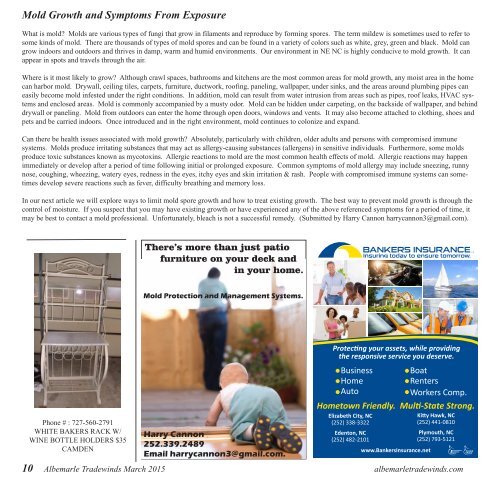Tradewinds March 2015 Web Final
March 2015
March 2015
You also want an ePaper? Increase the reach of your titles
YUMPU automatically turns print PDFs into web optimized ePapers that Google loves.
Mold Growth and Symptoms From Exposure<br />
What is mold? Molds are various types of fungi that grow in filaments and reproduce by forming spores. The term mildew is sometimes used to refer to<br />
some kinds of mold. There are thousands of types of mold spores and can be found in a variety of colors such as white, grey, green and black. Mold can<br />
grow indoors and outdoors and thrives in damp, warm and humid environments. Our environment in NE NC is highly conducive to mold growth. It can<br />
appear in spots and travels through the air.<br />
Where is it most likely to grow? Although crawl spaces, bathrooms and kitchens are the most common areas for mold growth, any moist area in the home<br />
can harbor mold. Drywall, ceiling tiles, carpets, furniture, ductwork, roofing, paneling, wallpaper, under sinks, and the areas around plumbing pipes can<br />
easily become mold infested under the right conditions. In addition, mold can result from water intrusion from areas such as pipes, roof leaks, HVAC systems<br />
and enclosed areas. Mold is commonly accompanied by a musty odor. Mold can be hidden under carpeting, on the backside of wallpaper, and behind<br />
drywall or paneling. Mold from outdoors can enter the home through open doors, windows and vents. It may also become attached to clothing, shoes and<br />
pets and be carried indoors. Once introduced and in the right environment, mold continues to colonize and expand.<br />
Can there be health issues associated with mold growth? Absolutely, particularly with children, older adults and persons with compromised immune<br />
systems. Molds produce irritating substances that may act as allergy-causing substances (allergens) in sensitive individuals. Furthermore, some molds<br />
produce toxic substances known as mycotoxins. Allergic reactions to mold are the most common health effects of mold. Allergic reactions may happen<br />
immediately or develop after a period of time following initial or prolonged exposure. Common symptoms of mold allergy may include sneezing, runny<br />
nose, coughing, wheezing, watery eyes, redness in the eyes, itchy eyes and skin irritation & rash. People with compromised immune systems can sometimes<br />
develop severe reactions such as fever, difficulty breathing and memory loss.<br />
In our next article we will explore ways to limit mold spore growth and how to treat existing growth. The best way to prevent mold growth is through the<br />
control of moisture. If you suspect that you may have existing growth or have experienced any of the above referenced symptoms for a period of time, it<br />
may be best to contact a mold professional. Unfortunately, bleach is not a successful remedy. (Submitted by Harry Cannon harrycannon3@gmail.com).<br />
<br />
<br />
<br />
<br />
Phone # : 727-560-2791<br />
WHITE BAKERS RACK W/<br />
WINE BOTTLE HOLDERS $35<br />
CAMDEN<br />
<br />
<br />
<br />
<br />
<br />
Business<br />
Home<br />
Auto<br />
Boat<br />
Renters<br />
Workers Comp.<br />
<br />
<br />
(252) 338-3322<br />
<br />
(252) 482-2101<br />
<br />
<br />
(252) 441-0810<br />
<br />
(252) 793-5121<br />
10 Albemarle <strong>Tradewinds</strong> <strong>March</strong> <strong>2015</strong> albemarletradewinds.com

















